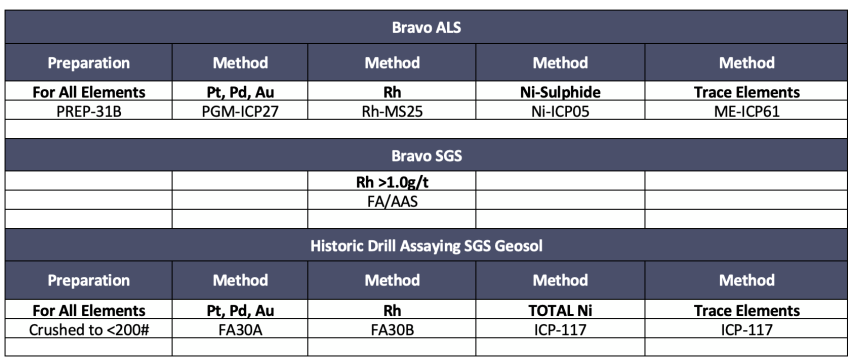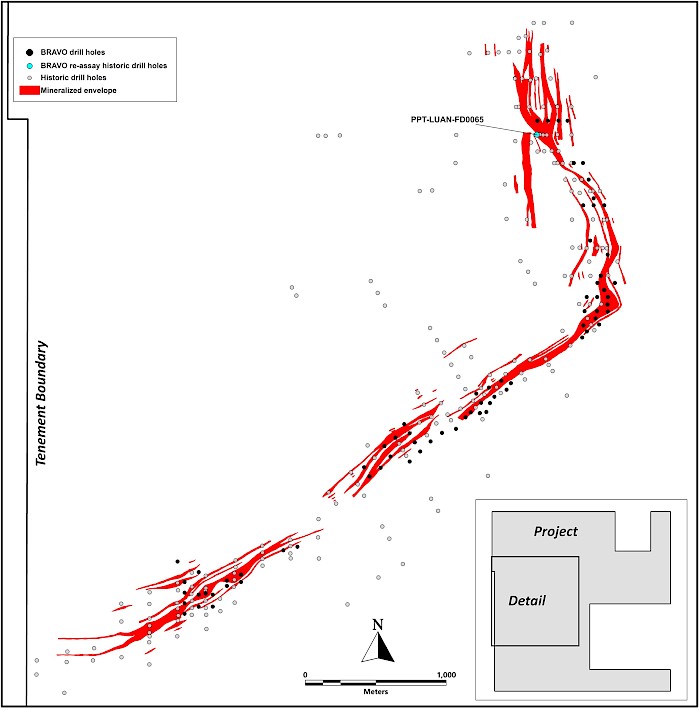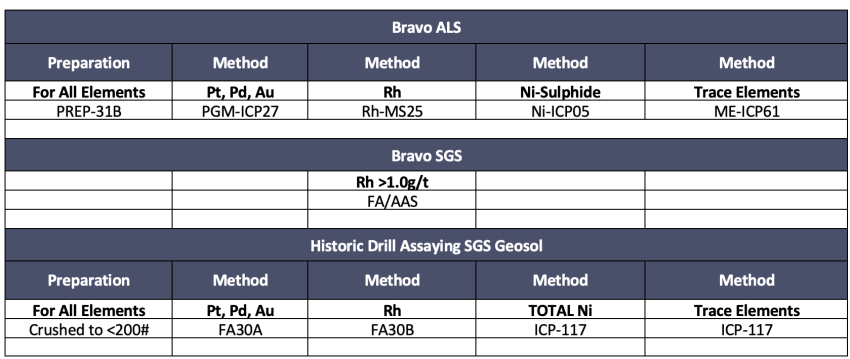VANCOUVER, October 12, 2022 – Bravo Mining Corp. (TSX.V: BRVO, OTCQX: BRVMF), (“Bravo” or the “Company”) today announced that it has received the overlimit (>1.0 g/t) rhodium (“Rh”) assay results from drill hole PPT-LUAN-FD0065 at its wholly owned Luanga palladium + platinum + rhodium + gold + nickel project (“Luanga” or “Luanga PGM+Au+Ni”), located in the Carajás Mineral Province, state of Pará, Brazil. Preliminary results for PPT-LUAN-FD0065 were announced in the news release dated September 27th, 2022, reporting re-assay of samples from historic diamond drill holes (“DDH”). These results included a 2m interval that exceeded the upper limit of 1.0g/t rhodium for the assay methodology used. This sample was re-assayed for rhodium using the applicable methodology for higher rhodium grades and has returned exceptional rhodium values.
“We are highly encouraged that PGM intercepts are proving to not only correlate well with historic results in thickness but can show significant improvements in grade on re-assay,” said Luis Azevedo, Chairman and CEO of Bravo. “We are particularly excited by the high rhodium assay results and believe that the Luanga deposit could be a rare example globally due to its concentration of valuable rhodium metal, particularly in some parts of the deposit.”
Highlights
- Mineralized intercepts from the re-assay of historic drill core continue to correlate with the historic intercepts, including intervals where rhodium assay results were >1.0 g/t Rh.
- Highlights from drill hole PPT-LUAN-FD0065, which now include overlimit rhodium re-assays, are tabulated below, with details and comparisons attached:

Notes: All ‘From’, ‘To’ depths, and ‘Thicknesses’ are downhole.
Given the orientation of the hole and the mineralization, the intercept is estimated to be 85% of true thickness.
Type: Ox = Oxide. LS = Low Sulphur. Recovery methods and results will differ based on the type of mineralization.
NA: Not Applicable as intercept is oxide or a mix of oxide and fresh rock mineralization.
- 84 drill holes have been completed for a total of 14,579 metres (or 57% of Phase 1 Drilling Program). Currently, samples from 34 drill holes are at the laboratory pending results.
- 13,910 samples submitted for assay to date including 2,964 re-assay samples from historic drill core.
- 6 drill rigs continue to operate onsite.
Luanga Re-Assay and Phase 1 Drilling Progress
A comparison of the historic intercept with the Bravo re-assay result for PPT-LUAN-FD0065 is tabulated below, with a plan showing the location of the drill hole. The thickness for the overall intercept and the higher-grade section within it correlate well with the historic intercepts, with the exception of Rh which significantly exceeds the historic values.
Comparison of Re-Assayed Intercepts – Historic Intercept (SGS Laboratory) versus Bravo Intercept (ALS Laboratory)

Individual Re-Assay Grades of Intercections (PPT-LUAN-FD0065) – Bravo, ALS Laboratory

Individual Original Assay Grades of Intersections (PPT-LUAN-FD0065) – Vale, SGS Laboratory

Notes: All ‘From’, ‘To’ depths, and ‘Thicknesses’ are downhole.
Given the orientation of the hole and the mineralization, the intercept is estimated to be 85% of true thickness.
Type: Ox = Oxide. FR = Fresh Rock. LS = Low Sulphur. Recovery methods and results will differ based on the type of mineralization.
NA: Not Applicable as intercept is oxide or a mix of oxide and fresh rock mineralization.
* = Note that Bravo’s nickel grades are for sulphide nickel, which is representative of potentially recoverable (by froth flotation treatment) nickel, and does not include non-recoverable silicate nickel, unlike historic total nickel assays.
The Phase 1 diamond drill program continues as planned at Luanga. Six drill rigs are on site, with drilling progressing in various locations along the entire 7km strike length of the known Luanga mineralized envelope (as defined by historic drilling). To date, 84 drill holes have been completed, for a total of 14,579 metres of the planned 25,500 metre Phase 1 drill program.

Location of Historic Drill Hole Results Discussed in this Report
About Bravo Mining Corp.
Bravo is a Canada and Brazil-based mineral exploration and development company focused on advancing its Luanga PGM + Au + Ni Project in the world-class Carajás Mineral Province of Brazil.
The Luanga Project benefits from being in a location close to operating mines, with excellent access and proximity to existing infrastructure, including road, rail and clean and renewable hydro grid power. The project area was previously de-forested for agricultural grazing land. Bravo’s current Environmental, Social and Governance activities include replanting trees in the project area, hiring and contracting locally, engagement with local communities, and ensuring protection of the environment during its exploration activities.
Technical Disclosure
Technical information in this news release has been reviewed and approved by Simon Mottram, F.AusIMM (Fellow Australia Institute of Mining and Metallurgy), President of Bravo Mining Corp. who serves as the Company’s “qualified person”, as defined in National Instrument 43-101 Standards of Disclosure for Mineral Projects (“NI 43-101”). Mr. Mottram has verified the technical data and opinions contained in this news release.
For further information about Bravo, please visit www.bravomining.com or contact:
Alex Penha
EVP Corporate Development
Forward Looking Statements
This news release contains forward-looking information which is not comprised of historical facts. Forward-looking information is characterized by words such as “believe”, “exceptional”, “highly encouraged”, “correlate”, “significant”, “improvement”, “highly encouraged”, “rare”, “valuable”, and other similar words, phrases or statements that certain events or conditions “could”, “should”, or “will” occur. In particular, this news release contains forward-looking information pertaining to the Company’s ongoing re-assay and drill programs and the results thereof and the potential for a continued increase in grades relative to historic assays. Forward-looking information involves risks, uncertainties and other factors that could cause actual events, results, and opportunities to differ materially from those expressed or implied by such forward-looking information. Factors that could cause actual results to differ materially from such forward-looking information include, but are not limited to, changes in the state of equity and debt markets, fluctuations in commodity prices, delays in obtaining required regulatory or governmental approvals, environmental risks, limitations on insurance coverage; and other risks and uncertainties involved in the mineral exploration and development industry. Forward-looking information in this news release is based on the opinions and assumptions of management considered reasonable as of the date hereof, including, but not limited to, the assumption that the assay results confirm the interpreted mineralization contains significant values of nickel, copper and also contain PGMs and Au; final drill and assay results will be in line with management’s expectations; that re-assayed may continue to outperform historic grades; that activities will not be adversely disrupted or impeded by regulatory, political, community, economic, environmental and/or healthy and safety risks; that the Luanga Project will not be materially affected by potential supply chain disruptions; and general business and economic conditions will not change in a materially adverse manner. Although the Company believes that the assumptions and factors used in preparing the forward-looking information in this news release are reasonable, undue reliance should not be placed on such information. The Company disclaims any intention or obligation to update or revise any forward-looking information, other than as required by applicable securities laws.
Schedule 1: Drill Hole Collar Details

Schedule 2: Assay Methodologies and QAQC
Samples followed chain of custody between collection, processing and delivery to the ALS laboratory in Parauapebas, state of Pará, Brazil. The drill core was delivered to the core shack at Bravo’s Luanga site facilities and processed by geologists who inserted certified reference materials, blanks and duplicates into the sampling sequence. Drill core was quarter cut and placed in secured polyurethane bags, then in security-sealed sacks before being delivered directly from the Luanga site facilities to the Parauapebas ALS laboratory by Bravo staff. Additional information about the methodology can be found on the respective ALS or SGS global websites (ALS, SGS) in their analytical guides. Information regarding preparation and analysis of historic drill core is also presented in the table below, where the information is known.
Quality Assurance and Quality Control (“QAQC”) is maintained internally at the lab through rigorous use of internal certified reference materials, blanks, and duplicates. An additional QAQC program is administered by Bravo using certified reference materials, duplicate samples and blank samples that are blindly inserted into the sample batch. If a QAQC sample returns an unacceptable value an investigation into the results is triggered and when deemed necessary, the samples that were tested in the batch with the failed QAQC sample are re-tested.

